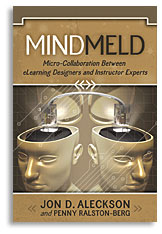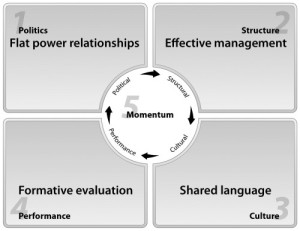Exclusive Interview with Dr. Jon Aleckson, Author of MindMeld: Micro-Collaboration between eLearning Designers and Instructor Experts
Dr. Saba: Dr. Aleckson, please tell us about your educational and professional background and how did you become interested in online learning?
Dr. Aleckson: I have been interested in how technology can improve the teaching/learning transaction since I proudly wore my “AV Pin” in fifth grade while I threaded 16mm projectors for teachers. Film provided a vehicle to emotionally engage learners. My undergraduate work at the University of Wisconsin in the 1970s focused on documentary filmmaking and educational technology. At the time, we were looking at ½ inch black and white videotape and Kodachrome slide shows. A main driver for Educational Technology has always been accessibility and cost. Videotape allowed educators to begin mimicking the impact of 16mm films. However, it was the emergence of the personal computer that has had the most impact on Educational Technology. Computer programs empower students through adaptive learning and take learners down a new branch based on choices made. Although my creative instincts germinated with the use of film and videotape, my entrepreneurial nature assembled teams of programmers to build better computer programs, designed to teach with increased high student engagement. For the last 25 years, I have been interested in development and delivery of computer-based learning activities. Fortunately I was able to make a living at it in the private sector, first doing educational videos then computer-based training. The Internet has proven to be the mother lode of all delivery methods. I realized at the beginning of this new century that to really lead a private sector education company, I needed stronger credentials. I returned to the UW for 7 years of part-time classes and earned my PhD in 2010. I shared the value of getting my degree in Managing eLearning blog post:
The applied wisdom shared in MindMeld was generated from 25 years of leading teams to develop and deliver computer-based education, while the ability to communicate this wisdom came from my PhD studies―especially the research and writing conducted for my dissertation.
I built a micro-collaboration model to assist informal and formal project team leaders to think deeply about encouraging micro-collaboration between the design and development teams and instructor-experts.
Dr. Saba: MindMeld is truly multifaceted. What was your core motivation behind writing the book?
Dr. Aleckson: Building immersive online experiences for students not only requires a team approach, but requires that the instructor-expert be immersed as part of that team. As computer programming becomes ubiquitous and less expensive, the demand for sophisticated interactive immersive educational experiences will grow. In this context there is a greater need to collaborate intensely with instructor-experts. A professor will no longer be able to author alone with minimal technical assistance.
By nature, I enjoy reflecting on how to better lead teams towards creating learning activities that inspire learners. I have worked in the trenches of development and seen failures and successes. No one person can do it all; many different skills and types of experts are required for success. You have graphic artists and computer programmers, and you have the instructional designers/writers. Most importantly, you have the person who is the expert on the content. These instructor-experts have great impact on the quality of the educational activity. I noticed at my practice that when the instructor–expert (we call them SME―Subject Matter Expert) was more engaged in the project, the quality of the computer learning activity was better. In the private sector, working with subject matter experts is very challenging. It is the equivalent to working on a distance education course with a superstar professor. The typical profile of an instructor-expert is someone who is self-assured about his/her abilities, has extensive experience, and whose time is in huge demand. Plus they are generally not paid much, if at all, for this extra effort of sharing their expertise so others can learn from it. The challenge is finding a way to maximize their passion for the project. I was fortunate through the help of my advisor, the legendary Alan B. Knox, to be allowed to focus my research on three transformation game and simulation projects being developed at the University of Wisconsin’s Engage Program
This provided me the opportunity to observe and reflect on development teams unrelated to my workplace. It helped me understand the higher education perspective, both the challenges and opportunities. These real stories combined with my own practical experience allowed me to develop a model of micro-collaboration. It also provided me with concrete evidence of how to engage and involve instructor-experts.
Dr. Saba: The relationship between instructional designers and faculty/experts has always been an important subject. Your approach towards the subject is unique and refreshing. Would you explain what your approach is in MindMeld?
Dr. Aleckson:I built a micro-collaboration model to assist informal and formal project team leaders to think deeply about encouraging micro-collaboration between the design and development teams and instructor-experts. This team approach to micro-collaboration starts with a joint effort to flatten power relationships and share knowledge. The instructor-expert knows the content domain, the team understands the technology. Generally, a subject matter expert will become more engaged in the process if there is a
clearly defined development process, along with good management of that process. There needs to be a concerted effort to use tools and techniques to build better communications and ultimately, a shared language. There also needs to be a formal approach to evaluation while the project is still in development. This formative evaluation means there is a plan to test, at various development stages, using student “user testers.” And lastly, team leaders need to monitor and encourage project momentum.
Dr. Saba: As I mentioned MindMeld is truly multidimensional. Who would primarily benefit from reading the book?
Dr. Aleckson: Frankly, all team members would benefit from this book. I recently spoke to a group of educational program managers (Deans) at a large online university. I emphasized my pet peeve that in higher education, personnel managers expect instructional designers to be the projects’ manager. Ever tried to keep someone on a development schedule without any formal authority to do so? This is a role for a designated project manager or for the dean―someone to provide the project management. Also, some universities do not formally adopt a team approach, expecting one instructional designer to gather necessary resources, including finding the in-demand computer programmer. What I am getting at is that this book is as much for deans and faculty members as it is for the design and development teams (assuming there is a formal team assembled). Of course, I am assuming the team is developing a sophisticated, computer-driven, learning activity, like a game or simulation.
Dr. Saba: How do you see the future of online collaboration in light of the emergence of more complex technologies?
The more complex the learning activity in a game or simulation, the more micro-collaboration is needed.
Dr. Aleckson: As a part of developing a shared language between design and development teams and the instructor-experts, I encourage the use of a grid to determine and communicate the complexity of the learning activity being built. The more complex the learning activity in a game or simulation, the more micro-collaboration is needed. I like to give the example of how a dialogue engine or “choose your own adventure” story software can only go so far by itself. The learning activity is of quality only if the instructor-expert contributes content domain information and computer responses based on expert practical wisdom. You could have the best technology and software, but without the involvement of a passionate instructor-expert you can easily fall into creating a decision-making branching dialogue scenario that ends up being very trite. So as technology becomes more complex, the need to collaborate becomes even more necessary for the development of quality online learning activities.

Order the Book
Jon Aleckson, PhD, has managed eMedia development for 30 years in private practice and in 2009 conducted his doctoral research on discovering ways to increase collaboration with experts to enhance online simulations, games and other advanced online learning activities. Jon is currently CEO of Web Courseworks, a 25 person eLearning software development company. Jon writes “Managing eLearning,” a blog about effective leadership and entrepreneurial opportunities in eLearning. Jon is also adjunct faculty at University of Wisconsin-Platteville where he teaches an Introduction to Distance Education Leadership online course. Jon has helped manage the development of online learning programs for adult learners, and K-16, including design and development of courses and serious games, for corporations and associations such as the Credit Union National Association, Alliance for Continuing Medical Education, World Anti-Doping Agency, and McDonald’s Corporation, and numerous national associations’ professional development programs. Jon authored the book titled MindMeld published by Atwood Publishing.










